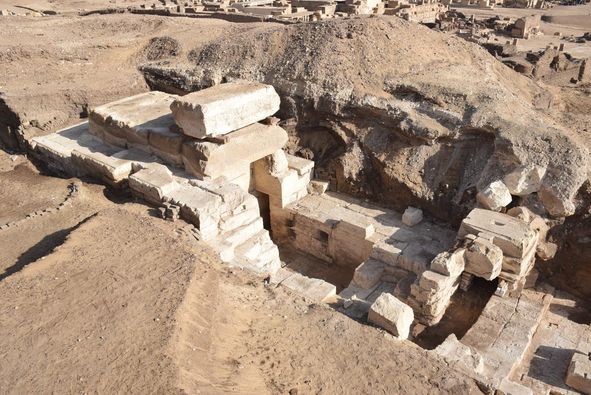Mysterious 2,100-year-old gate believed to hide ancient Egyptian god of fertility’s secret temple is unearthed
Archaeologists have discovered a massive 2,100-year-old entrance in an ancient Egyptian village.
Originally standing up to 60 feet (18 meters) tall, the secret entrance is located in the old town of Athribis, close to the present-day city of Sohag.
It leads to an undiscovered room that researchers think might be the entrance to a long-gone temple.
According to archaeologists Dr. Marcus M.ller and Professor Christian Leitz of the University of T. Bingen, the entrance to a temple in the rock is thought to be beneath the undiscovered masses of debris behind it.
A second door on the pylon’s front is unique in Egyptian temple construction. It connects to an unidentified stairway that led up to four flights to the upper floor, which is now damaged, and where further storage spaces can be built.
There may be a door behind it, as indicated by the more than three-meter-high find and features that are typical of a temple’s top end, including a cobra frieze.
However, more excavations will be needed to demonstrate this.
After a 20-ton ceiling block that had fallen over time was removed, the chamber—which is about 6 meters long and 3 meters wide—was found.
The tiny space was probably used to store amphora, which are oval containers used for wine, oil, and resin, as well as utensils.
On the finding, Leitz and Mller have been collaborating with Egypt’s Ministry of Tourism and Antiquities.
The two further mentioned that since 2012, excavations have been conducted to reveal an ancient temple district constructed between 144 BCE and 138 CE.
The towers of the imposing temple entrance were each 18 meters high, and the complex was 51 meters broad overall.
Only about 5m are left today. The others became victims of quarrying.
Revealing the Hidden Secrets of Egyptian Pyramid Construction (1)
The exterior facade and interior walls of the gateway are adorned with elaborate carvings and Egyptian inscriptions.
According to the hieroglyphics, the pylon was built by Ptolemy VIII in the second century BCE.
The Egyptian fertility deity Min, his wife Repit, who is frequently portrayed as a lioness, and their son, the child-god Kolanthes, are all shown in the inscriptions.
The fertility deity Min is shown on the door frame across from the goddess Repit, who is once more visible. She is accompanied by two infrequently seen creatures, decans (stars that allow time to be counted at night), who have the heads of an ibis and a falcon, respectively, according to Leitz and Mller.
In one inscription, a king—whom the scholars believe to be Ptolemy VIII from the second century BC—is offering sacrifices to these Egyptian deities.
The political and military rivalry between Ptolemy VIII and his elder siblings were well-known.
Throughout his administration, which lasted from 170 to 164 BCE, he alternated between ruling alone and with others.
The first expedition of its kind was funded by Ptolemy VIII in 117 and traveled to India via the Indian Ocean and Red Sea.
Read More on The US Sun
Egypt became interested in the spice trade as a result of this mission.
A brief history of Ancient Egypt
Here’s all the information you require…
- The Ancient Egyptians were an advanced civilisation who at one point owned a huge portion of the globe
- The civilisation began about 5,000 years ago when ancient humans began building villages along the River Nile
- It lasted for about 3,000 years and saw the building of complex cities centuries ahead of their time as well as the famous Great Pyramids
- The Ancient Egyptians were experts at farming and construction
- They invented a solar calendar, and one of the world s earliest writing systems: The hieroglyph
- The Egyptians were ruled by kings and queens called pharaohs
- Religion and the afterlife were a huge part of Ancient Egyptian culture. They had over 2,000 gods
- Pharaohs built huge elaborate tombs to be buried in, some of which were pyramids at the time among the largest buildings in the world
- The Egyptians believed in life after death, and important people s corpses were mummified to preserve their bodies for the afterlife
- The Ancient Egytpian empire fell due to a mix of factors, including wars with other empires and a 100-year period of drought and starvation
Note: Every piece of content is rigorously reviewed by our team of experienced writers and editors to ensure its accuracy. Our writers use credible sources and adhere to strict fact-checking protocols to verify all claims and data before publication. If an error is identified, we promptly correct it and strive for transparency in all updates, feel free to reach out to us via email. We appreciate your trust and support!













